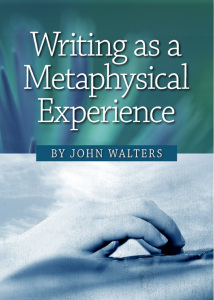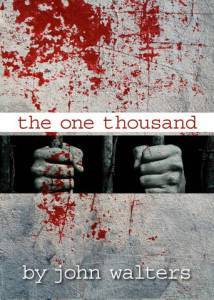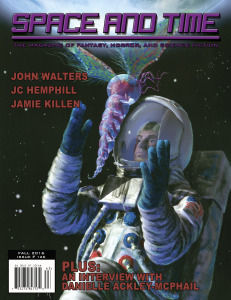John Walters's Blog, page 53
November 6, 2016
Book Review: Wolf: The Lives of Jack London by James L. Haley
Reading about the life of Jack London had an enormous effect on me when I was a young writer. Inevitably when I read a new biography of London I compare it with the book that introduced me to him, Jack London: Sailor on Horseback by Irving Stone. Also inevitably, the biographies I have read since fall short of providing the riveting experience of my first introduction to the author’s life. Some have given more details and possibly have been better researched, but none has engaged my emotions and empathy as a fellow writer as much.
This one I found by chance while browsing library shelves in the biography section. It’s not the newest biography of London, but I had never heard of it before so I decided to give it a try. It’s divided into sections corresponding to various facets of London’s life, such as “The Student,” “The Prospector,” “The Aspiring Writer” and so on. Such a contrivance cannot, of course, be sharply delineated, and there is overflow of themes from chapter to chapter.
This book is fairly short as far as biographies go. Although in the introduction the author makes claims to delving deeper and more thoroughly into London’s life than others, in fact it is a fairly swift overview of the main points of the author’s life, skipping over a number of sometimes important details (such as the crucial sale of the short story “An Odyssey of the North” to The Atlantic Monthly early in his career) that other biographers include. Haley lingers in a few places to give more detailed explanations: for instance, in England when London went underground amidst the poor to research his sociological book The People of the Abyss, but for the most part he merely touches on the main points and then moves swiftly on. Most of the chapters, such as those on the Klondike, London’s struggles as a young writer, and the journey through the South Pacific aboard his sailing ship the Snark would have benefited by being much, much longer. In the closing chapters especially, Haley seems in a rush to finish up, and skims over or skips a lot of important information.
Still, the book is readable and interesting, dealing as it does with one of the most charismatic and adventurous writers in American literature. Jack London never even finished high school. Determined to be a writer despite the handicaps of his background and environment, he educated himself, learned the basics of how to submit to magazines, and through hard work, talent, and persistence became the most famous and well-paid writer of his time. Many of his works are as readable now as when they were first published, particularly his short stories, his novella The Call of the Wild, and his autobiographical novel of his struggles as a writer, Martin Eden. Aspiring writers can learn a lot about short story technique by reading some of his classics such as “The White Silence,” “The Apostate,” and “The Red One.”
In short, this biography is readable, but not as comprehensive as others I’ve read. And if you’re an aspiring writer and want a torrential rush of inspiration, read Jack London: Sailor on Horseback.


October 29, 2016
When the Threat of Violence Rears Its Ugly Head
Perhaps I have become too complacent. We live in a fairly safe area. It’s normally fine to walk the streets either during the day or at night; there are rarely questionable characters lurking about. Walking is important to me. I have to get away from the computer, stretch my legs, and see the outside world. It’s not enough to do my three-times-a-week yoga and calisthenics routine, although I am faithful with that as well. I try to take a walk of at least a mile seven days a week.
I often combine my walk with chores such as shopping or going to the library. Since there are supermarkets in two different directions it gives me variety. Yesterday, for instance, I headed for the supermarket that is farther away because I had noticed some items for sale in its weekly flier. If possible I stick to the side streets in this suburban area, as the air is cleaner and the view is more attractive.
I walk at a steady pace, not too fast and not too slow, keeping my breathing regular. Since my recent fall when I broke my wrist, I watch out for cracks and other imperfections in the sidewalk or street. I look at and appreciate everything as I pass: the architecture of the houses, the number of floors, the windows, the porches, the balconies, the paint, the extensions, the yards, the moss or lack of it in the driveways, the yards or gardens and the way they are kept up or neglected, the idiosyncratic decorations, the scattered toys, the political signs, the evergreens towering over all, and in these days before Halloween, the carved pumpkins. Our neighborhood is replete with greenery, and the houses for the most part are attractive and cozy-looking.
So I take my walk, as usual, and I have just gone under the supermarket overhang and am reaching for a shopping cart when someone comes up behind me and says, “Do I know you?”
I turn. He’s younger than I am, perhaps about half my age, so he’s not an old classmate from my long-ago school days. I suppose I might have met him at a writing seminar or science fiction convention, but he doesn’t look familiar.
Plus he has a very unfriendly expression.
I mumble something about not recognizing him. He replies by saying he lives in one of the houses I recently passed. I say, “Oh, which one?” And he says, “None of your business.”
That’s when the alarm bells start going off. After all, he’s the one that accosted me, not vice-versa. I was just going about my day.
Then he says, “I see you pass my house a lot. You look at it.”
Well, okay, I pass by a lot of houses every day, and I look at all of them. He’s not giving me much to go on.
But then it strikes me: he has been following me, stalking me in a sense, for God knows how many blocks, just because I happened to pass by his house and look at it. If, indeed, he really does live in a house in the neighborhood, which I’m beginning to have my doubts about. He had a distinctly malevolent and psychotic expression. It makes no sense, and it really creeps me out.
Okay, so I went into the supermarket and did my shopping. He went in too and pretended to shop, or bought one little item to justify his following me into the store. On the way home I took another route, avoiding the temptation to constantly keep looking behind me but glancing back from time to time to be sure he wasn’t following. When I got closer to home I increased my surveillance, as I didn’t want him to find out where I lived. For the next hour or two I would periodically look out my second-floor windows to be sure he wasn’t spying on us.
Maybe I was being excessively paranoid, but I think I will avoid walking along the street in question for now. He came across as the type of guy who would, the next time he saw me, rush out with a pistol or shotgun to supposedly defend his turf. Understand: on my walks I never slow down or stop, and I never walk on anyone’s lawn or garden. I stick strictly to the public sidewalks and roadways. I’m sure other people take walks in their neighborhoods – I mean, why the hell not?
The experience reminded me that some people have a spirit of violence deep down in their souls, and it’s ready to burst at any time, at the slightest provocation. I’ve met a lot of people like that on my travels around the world, but I have been lulled into a sense of safety by this normally safe neighborhood we presently live in. It made me wonder how often such things would happen if I dressed oddly or were a person of color. Many people because of their appearance have to undergo stark, random, bizarre, unfriendly, and inconsiderate encounters like this on a regular basis.
This world of ours can be fascinating and gorgeous, but it can also be abruptly cruel without warning. It pays to always be aware and on guard as you enjoy the beauty.
* * *
After I wrote the above, I still felt puzzled and disturbed by this incident, but I couldn’t really put it all together until this afternoon. I’ve started reading (or rather rereading – it all sounds familiar and I’m sure I must have read this several decades ago) A Moveable Feast, Ernest Hemingway’s memoir of his years as a young writer in Paris. Then it all came back to me. I realize that I see few other pedestrians when I take my walks here in the neighborhood. In the States, at least around here, people drive from place to place. I have lived almost twenty years in Europe, mostly in Greece and Italy but also in the Netherlands and other places. Europeans are great walkers, great strollers, and they would find it inconceivable that someone would object to pedestrians gazing upon their houses as they passed, or even stopping to admire and comment upon particularly striking aspects of them. The owner might come out and chat, and both residents and pedestrians would benefit from the experience. This reluctance and lack of openness to the views of passers-by is a solely American paranoia, and it is a sad one. That’s not to say all Americans are like this – I have met congenial neighbors on my strolls – but it would never happen, for instance, in Greece. There the people you pass by would be more likely to invite you in for a coffee or a quick sip of ouzo.


October 22, 2016
What Star Trek Means to Me
I recently started re-watching the original Star Trek series on Netflix. You know, the one with Captain Kirk and Mr. Spock and Bones the doctor, not to mention Scottie, Uhura, Sulu, and the rest of the crew.
It’s been decades since I’ve seen some of the episodes. In fact, as I watch I realize that I have never seen many of the episodes in color before. That’s right: when I first discovered the series in 1966 when I was thirteen years old, our family had only a black and white TV, and even in the years to follow, as the series ended and reappeared in syndication, I always watched it in black and white. My parents didn’t buy a color TV until after I was grown and gone. It didn’t matter. The series enthralled me as no other television series ever had. I was hooked on the adventures of the crew of the Enterprise long before I even understood what science fiction was or had read much of it. I’d read some Heinlein, sure, but that was about it.
Something about Star Trek ignited my imagination. Nowadays, in retrospect, some of the plots seem contrived or cliché, but back then the show was all original, breaking new ground. Gene Roddenberry sought out acclaimed science fiction writers to script some of the episodes. I still remember, for instance, the first time I watched the episode “The City on the Edge of Forever” by Harlan Ellison. The ending devastated me. Many fans consider that episode the high point of the series, but for me there were many high points.
By the time I attended Clarion West with the aspiration of becoming a science fiction writer, Star Trek had already been long cancelled. I would have loved to have written for it. Some of my fellow attendees ended up writing for the animated Star Trek based on the original series.
Watching the original Star Trek today, you have to place it in context. You can’t compare it with these high-budget CGI-ridden modern TV series and films. Roddenberry was starting from scratch with no precedent, small budgets, no CGI, and unknown actors. He was confined by studio taboos and regulations, and also by the conservative sensibilities of the TV audiences of the era. It’s astounding that Star Trek even got off the ground and survived as long as it did. That it went on to spawn so many other series and films – an entire mega-universe – is all but unbelievable.
For me, Star Trek was the beginning of a life-long interest in speculative fiction in all its forms. It created a foundation of the fantastic. When I later discovered the literature of science fiction, Star Trek had already introduced me to many of the concepts with which even the best authors dealt. Watching Star Trek now is a journey through nostalgia, true – but many of the best episodes still hold up, as long as I don’t study them too closely or compare them with modern more sophisticated parallels. I’m content to take Star Trek on its own terms and wholeheartedly enjoy it for what it is – and was.


October 16, 2016
Book Review: The Year’s Best Science Fiction: Thirty-Third Annual Collection Edited by Gardner Dozois
This is a huge doorstopper of a book: almost 700 pages, more than 300,000 words of the editor’s selections of the best short science fiction published in 2015. Unlike other best of the year editors, Dozois sticks strictly to science fiction. No fantasy, magic realism, or any of those related genres in this anthology. Still, with every volume Dozois manages to come up with plenty of good stories, although not all are to my personal taste.
As he does every year, Dozois starts the book with a fascinating and comprehensive look at the year’s accomplishments in science fiction. This introduction is a monumental achievement and bespeaks a great deal of research. He doesn’t just cobble his facts together. The depth of his commentary makes it clear that he has invested a good part of the year in a thorough analysis of the field. He discusses science fiction book lines, professional magazine markets, semi-pro markets, anthology markets, short story collections, books of interest to the science fiction field, and includes the addresses of the publishers of most of these. He writes about science fiction films, TV series, conventions, and awards. He lists and eulogizes science fiction notables and peripheral figures who died in 2015. Besides all this material, he introduces each individual story with a brief biography of its author.
But it is the stories we come to the book for, and most of them do not disappoint. Some touched me deeply. Chief among these was a pair of novellas. “Gypsy” by Carter Scholz is the heartbreaking story of a starship on a desperate mission to escape a decimated Earth and start a new human colony elsewhere, as told by various passengers who wake up from cryogenic sleep at different points in their journey. “Inhuman Garbage” by Kristine Kathryn Rusch is a murder mystery set on the moon that calls into question the ethics of regarding clones as property. Many of the shorter stories are exemplary as well.
The thirty-six stories in this book offer plenty of variety, although they lean heavily towards hard science fiction, in which the technology predominates. In general, the strongest stories are those with coherent plots and characters, and the weaker stories come across as literary exercises rather than plotted stories. One story that consists of a series of loosely connected vignettes detailing alien oddities I was unable to finish, and one other I slogged through but was glad when it was over. That’s not bad: only two out of thirty-six that held nothing appealing for me at all. Much better odds than a mainstream collection I read earlier this year that was supposed to contain some of the best short stories of the last one hundred years.
Although his selections may not always appeal to me, I think that Dozois does the science fiction field a great service in offering this collection year after year. Every year hundreds if not thousands of science fiction stories are published, and somehow they have to be sorted for readers so that the better ones live on past their initial ephemeral appearances. The abundance of best of the year volumes ensures that stories appealing to diverse tastes are selected and will live on in private collections and on library shelves, there to be discovered by future readers in search of wonder.


October 8, 2016
Book Review: How to Write Like Tolstoy: A Journey Into the Minds of Our Greatest Writers by Richard Cohen
The title of this book, although catchy, is misleading. Personally, I wouldn’t want to write like Tolstoy anyway. I am perfectly content to write like John Walters. Anyway, the author makes no attempt to teach writing or techniques of writing. Instead, he catalogs how various famous writers dealt with various aspects of writing. The entire book is taken up with examples of writers’ attitudes towards beginnings and endings of novels, characters, plagiarism, points of view, dialogue, irony, story, prose rhythm, writing about sex, and rewriting. Again I emphasize: not to teach writing, but rather to entertain. And the book is entertaining; I’ll give it that, though some sections work far better than others.
The section on storytelling works well, because the author gets down into detail about what constitutes story and the basic plots in fiction. Other interesting sections include the looks at story beginnings, plagiarism, and writing about sex – although the author spends much more time decrying bad examples than applauding good examples. It is also fascinating to read what various writers think about revising. As Cohen emphasizes, there are as many opinions about these various aspects of the writer’s craft as there are writers. The short chapter on dialogue didn’t do much for me, probably because I recently read Robert McKee’s comprehensive book on dialogue. Some of the other more esoteric sections, such as those on rhythm and irony in novels, didn’t really have much to say, probably because the subjects are difficult to pin down.
My biggest objection to the material in this book is how the author limits the examples he uses. He leans heavily on classic writers such as Tolstoy, Austin, Lawrence, Joyce, Hemingway, and a few others. Some contemporary writers are mentioned in passing, but not many. Of popular genre writers, Cohen cites only Stephen King and Ray Bradbury. In the section on sex, he dismisses the contribution of Henry Miller to sexuality in novel writing with a footnote, which to me is an injustice. If the author had been more open to the wonderful diversity found in fiction, the book would have been much more comprehensive and enjoyable.
Still, it is what it is, and as I said, it is readable and enjoyable. Too bad about that title though. Some would-be writers might pick up this book thinking they are getting a how-to volume on the making of epic novels, whereas nothing could be further from the truth. If this book is instructional to writers at all, it is to show that there is no one way to write, and no definitive rules on what constitutes correctness, let alone excellence, in the various mechanisms that make up a piece of writing. Perhaps that was the author’s objective all along: to demonstrate the idiosyncrasies of writers, to highlight their individuality and unique ways of approaching their work. That’s what it did for me, anyway, besides offering a good laugh here and there. It reinforced the conviction I already hold that once you learn the basic tools of the trade, there is no correct or incorrect way to write. Writers are individuals, each with his or her unique method of creation. Writing is a voyage of discovery, as Henry Miller said in his excellent essay “Reflections on Writing.” It is akin to taking to the open road that Whitman wrote about. Every writer’s journey is a singular one. That is the glory of it.


October 2, 2016
Writing as a Metaphysical Experience
My new book, Writing as a Metaphysical Experience, is now available as an e-book at multiple outlets, including Amazon, Barnes & Noble, Kobo, Apple iBooks, and others. It’s also available as a print edition here.
It’s part memoir, part journal, and part instruction. Here’s an excerpt from the introduction:
“For me, writing is metaphysical because it is inseparable from who I am and my conception of the universe and my place in it. My interpretation of writing goes far beyond the definitions of hobby, job, or career – it is rather in the nature of a calling. It is something that blossoms from within me and, though invisible to instrumentation, is as integrally a part of me as my flesh, bones, and internal organs. How this transpired and how it manifests itself is the subject of this book.
This is not a how-to book on writing, although in its course I offer many practical tips and suggestions. It’s more like a travelogue, a story of the life’s journey on which my writing has led me.”
This writing journey has led me on a decades-long quest from the United States to Europe to the Indian Subcontinent and back in the pursuit of voice, inspiration, and literary excellence. On the way, I have written and published novels, short story collections, essay collections, memoirs, and numerous individual novellas, novelettes, short stories, and essays.
If the “pursuit of voice, inspiration, and literary excellence” fascinates you, pick up a copy of the book, and you may find that you’re not alone in your creative struggles. Writing, if pursued with sincerity, is an all-consuming passion. Although it is not always an easy road to walk, for those who are called to the journey, it is an inevitability.


September 24, 2016
The One Thousand Series
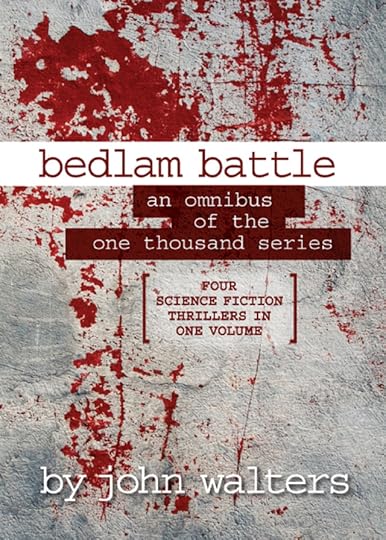 Bedlam Battle: An Omnibus of the One Thousand Series
Bedlam Battle: An Omnibus of the One Thousand Series
Four science fiction thrillers in one volume
The four novellas of the One Thousand series are now available in one all-inclusive volume. See below for links to distributors.
This omnibus includes:
It is the late 1960s…
What better place than prison to recruit psychopathic killers? So thinks Benny, possessed by a thousand alien entities which he intends to share around with the other inmates before unleashing hell on Earth in the form of a murderous rampage. Only William Stafford, a Vietnam War veteran unjustly convicted of killing a girlfriend, can stop him. But to do so he has to break back into the prison he has just escaped from…
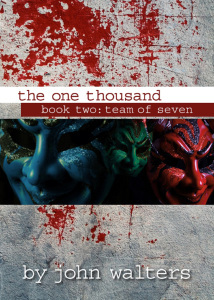 The One Thousand: Book 2: Team of Seven
The One Thousand: Book 2: Team of Seven
A team composed of counterculture humans and benevolent aliens based out of Haight/Ashbury hunt for murderous, alien-possessed convicts with enhanced powers who have escaped from prison. They discover that this fellowship of psychopaths is preparing an elaborate party for hippies and other street people in a remote mansion built to simulate a Medieval castle, and that they are planning to slaughter everyone who attends. Now the seven are faced with the task of locating the mansion and stopping the killers…
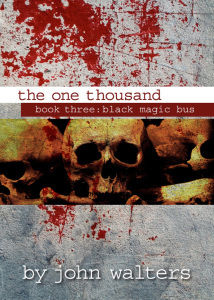 The One Thousand: Book 3: Black Magic Bus
The One Thousand: Book 3: Black Magic Bus
To escape pursuit, the fellowship of psychopaths has fled to Europe. In the mountains of Italy they customize a psychedelically-colored tour bus, intending not only to pick up and murder unwary young travelers, but deliver a cargo of lethal pathogens to a major city in the East. Only the Team of Seven composed of enhanced humans and benevolent aliens can find and stop them…
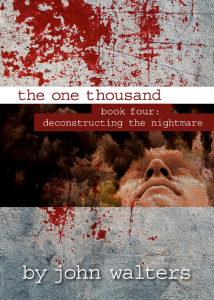 The One Thousand: Book 4: Deconstructing the Nightmare
The One Thousand: Book 4: Deconstructing the Nightmare
Their hunt for a group of alien-possessed psychopaths intent on igniting a rampage of mass murder leads the Team of Seven to a prison in Turkey, war-ravaged Vietnam, a luxurious nuclear fallout shelter, and finally to direct confrontation with their enemies.
Click to buy from these distributors:


September 17, 2016
Book Review: Zero K by Don DeLillo
The aftermath of reading this novel is a residual impression of the plot, characters, and imagery as a totality. However, it is a weak impression.
As soon as I heard about Zero K I decided to give it a read. After all, it’s seldom that a mainstream literary author ventures into the realm of science fiction, and I was curious how DeLillo would handle the material. Unfortunately, I am at present financially challenged, and I couldn’t afford the new hardcover price, not even with Amazon discounts. Additionally, the multiple copies in the Seattle Public Library system had long wait lines for holds. I thought I’d have to wait for the paperback, but then a copy of the book turned up at one of the cute local neighborhood outdoor lending libraries.
I have not read any of DeLillo’s other books, so I have no basis for comparison when discussing Zero K. I can only take it on its own merits and compare it to what I suppose that a science fiction writer would do with the material.
The story is narrated in first person by the son of a billionaire who has become fascinated by and is heavily donating to an independent organization called Convergence. It specializes in cryogenic preservation of people who are near death with a view to reviving them and extending their lifetimes in the future. The narrator’s stepmother is being frozen, and his father wants to do himself in too but ultimately decides to put it off for a time. Much of the first part of the book describes the cryogenic facility set in a Central Asian wasteland. The story then takes the narrator and his father back to New York, and finally they return to the cryogenic facility when his father decides to join the narrator’s stepmother in her frozen sleep/death.
The story moves glacially slow. I couldn’t help contemplating, as I read, what Roger Zelazny or Samuel Delaney, both great science fiction literary stylists, would make of the material. For one thing, I think they would write it much shorter, in novelette or novella form. There simply isn’t enough substance to justify the length. There are too many words, a lot of empty space within the text, and too little is said. Some of it makes sense within the context of the novel but much of it doesn’t. The characters, too, are like shadows: vapid, shallow. They do things that appear random and unmotivated. They are privileged people, and not people with whom one can empathize. DeLillo does not make much effort to give them the touches of humanity that would draw a reader into the story. Even when the narrator describes his past life and the events that precede his present actions, it is all laid out as an abstraction, like the description of the monotonous hallways in the underground complex.
I almost gave up on this book, it was so slow, but I persevered because I was curious how the author would resolve things. It all came out as I expected, no real surprises, and in the end I had the feeling that the story was okay but it would have been much stronger if at least half the extraneous material had been edited out. DeLillo is obviously a more than competent craftsman of the English language; he simply took the material that would have been concise and dynamic as short fiction and extended it too long.
As a foot note to this review, after I finished the book, I returned it to the neighborhood library where I had found it. These libraries are common around the area I live in, and are a relaxed and magnanimous way to share books with other bibliophiles. I have read comments in online forums by the paranoid that people might take some of the books and sell them on Amazon and other outlets. I don’t think that happens too often, as I often monitor the contents of the little library boxes around our area while I’m out for walks, and turnover is slow. But my response to this is: So what? If someone is so poor that they have to rob neighborhood libraries to earn a couple of bucks by selling books, I say that they’re welcome to them. There are plenty of books in the world, thank God.


September 10, 2016
“Heroes” in Space and Time
Most of my short story sales in recent years have been to anthologies, or book-length collections, so it’s fun to have a story appear in a magazine. The Fall 2016 issue of Space and Time: The Magazine of Fantasy, Horror, and Science Fiction just came out, and it includes my story “Heroes.” Although the magazine has not retained the same editor/publishers, Space and Time has been in continuous publication since 1966, so 2016 is its fiftieth anniversary. You can order single issues of the current magazine directly from the Space and Time website and electronic issues from Weightless Books.
Space and Time is one of the longest-running of the small press magazines devoted to the genre of speculative fiction. Such magazines contribute regularly to best-of-the-year anthologies and awards lists and are a viable alternative for authors who find it difficult to break into the few top-tier science fiction and fantasy magazines. They offer exposure to an established network of readers and a paycheck as well. It’s a win-win situation.


September 4, 2016
Book Review: Dialogue: The Art of Verbal Action for the Page, Stage, and Screen by Robert McKee
When I read books on writing, I don’t expect to agree with everything the author says. There are as many theories on writing as there are writers, and that’s as it should be. Still, the opinions and advice of others can help me sharpen my own tools of the trade. Robert McKee is renowned as a writing teacher, especially of screenwriting. I read his book Story: Substance, Structure, Style, and the Principles of Screenwriting years ago, and though I have never attempted to write a script, I found it valuable in planning the structure of some of my novels. This new book, Dialogue, takes a wider approach than Story, and encompasses not only writing dialogue for the screen, but also for plays and novels.
As I was reading the book, I came across a discussion of it on a blog focusing on indie writing that I frequently peruse. Those who contribute to the discussion boards have a tendency to be very opinionated, and this thread was no exception. There was a lot of criticism of McKee’s ideas, which is fine, but I think that some of the commentators missed the point. They are under no obligation, when they read a work like this, to take or leave the entire work as a whole. Some parts of it may be relevant or useful to them, while other parts may not. For me, McKee’s credentials and opinions are solid enough for me to at least listen to what he has to say.
The book starts slowly, with explanations of the basics of what constitutes dialog and what its functions are. Because I am so familiar with the concepts McKee presents in these chapters, I almost lost interest. I persisted, however, and was rewarded in later chapters when McKee analyzes specific scripts, plays, and novels to illustrate the principles he propounds.
There’s no harm in having a keener appreciation and understanding of the tools that a writer uses to bring about desired effects in his work. The danger comes in over-analysis of technique to the detriment of creativity. Dean Wesley Smith differentiates the creative side of a writer with the critical side, and stresses that if you overemphasize the critical, you can stifle the creative. He has a good point, of course, but there is a difference between over-analyzing your work so that it becomes a mass of disparate parts rather than a coherent whole, and being familiar with the tools of the trade with which you work.
In my opinion, McKee does fall into the trap of over-analyzing. He acknowledges that there is a difference between the creation of a work and analyzing it in aftermath. For writers, the best way to approach a book like this is to consider it a sharpening and fine-tuning of some of the tools that they use, and if there is any advice with which they disagree, they should feel free to completely ignore it. This book considers many nuances of dialogue, and it may be that after you have read it, you may be able to use some of its principles to bring the dialogue that you give the characters in your own works into sharper focus.



